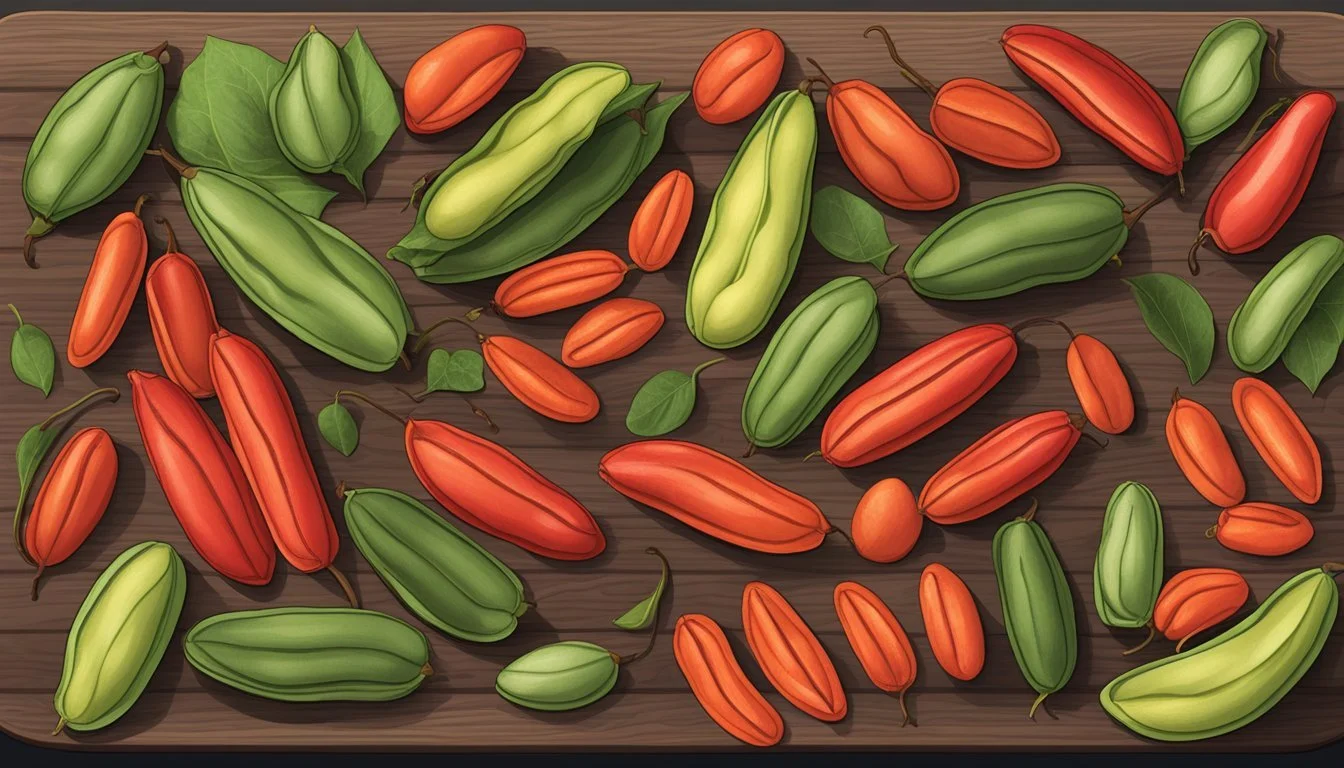Scarlet Runner Beans Substitutes
Top Alternatives for Your Recipes
Scarlet runner beans, also known by their scientific name Phaseolus coccineus, are a versatile ingredient with a rich history in many culinary traditions. These large, flavorful beans are a favorite in salads and side dishes, and their vibrant flowers make them a beautiful addition to any garden. But what do you do when you can't find these beans or need a quick substitute?
Lima beans are an excellent substitute for scarlet runner beans. Their similar size and texture ensure that your dishes maintain the right consistency and flavor profile. Another great alternative is black beans, which, while slightly different in taste, can provide the necessary protein and fiber content that scarlet runner beans are known for.
Using these substitutes allows you to enjoy the nutritional benefits of scarlet runner beans without disrupting your meal prep. Whether dried or fresh, these substitutes hold up well in various recipes, ensuring your dishes remain delicious and enjoyable.
Botanical Profile
Scarlet runner beans (Phaseolus coccineus) offer rich history and distinct plant characteristics. They are native to mountainous regions in Central America, particularly Mexico, and are known for their vibrant flowers and versatile uses.
Origin and Species Information
Scarlet runner beans belong to the Fabaceae family, a group known for its leguminous plants. They are native to Central America and thrive in the elevated terrains of Mexico.
This species distinguishes itself from common beans (Phaseolus vulgaris) due to its higher elevation growth habit. Historically, Phaseolus coccineus was first documented in the 1600s, finding a place in European and early American gardens both as a food source and an ornamental plant.
Today, scarlet runner beans are often grown for their attractive red flowers.
Plant Characteristics
Scarlet runner beans are twining perennial vines that are frequently cultivated as annuals in temperate climates. These plants can reach heights of up to 12 feet, showcasing large trifoliate leaves and striking scarlet flowers.
The flowers not only add aesthetic value but also attract pollinators like bees and hummingbirds. The beans themselves are usually elongated and may be consumed fresh, dried, or even stored for extended periods.
Cultivators appreciate their dual purpose: ornamental beauty and practical food usage. This versatility makes them a preferred choice for many gardeners, especially those interested in both aesthetics and edibles.
Cultivation Guidelines
Scarlet runner beans thrive when given the right conditions, including proper planting techniques, healthy soil, sufficient sunlight, regular watering, and appropriate structural support for their growth.
Planting Requirements
Scarlet runner beans should be planted directly outdoors once the risk of frost has passed and the soil has warmed up to at least 50 degrees Fahrenheit. Spring is the ideal season for planting.
Seeds should be sown about 1 to 1.5 inches deep with a spacing of around 6 inches between each seed. Germination typically occurs within 7 to 14 days under optimal conditions. For container gardening, use deep pots to accommodate the extensive root systems.
Soil and Sunlight Needs
Scarlet runner beans prefer well-draining soil that is rich in organic matter. A pH level between 6.0 and 6.8 is ideal. They perform best in full sun conditions, requiring at least 6-8 hours of direct sunlight per day.
To improve soil fertility, incorporate compost or well-rotted manure before planting. Mulch can be added around the base of seedlings to retain moisture and suppress weeds, facilitating healthy growth.
Watering and Fertilization
Regular watering is essential, especially during dry periods. Maintain consistent moisture without waterlogging the soil. A general rule is to provide 1 inch of water per week, adjusting based on weather conditions.
Avoid over-fertilizing as it can lead to excessive leaf growth with fewer beans. A balanced fertilizer applied sparingly can support healthy growth. Organic options are preferable to minimize harm to pollinators and beneficial insects.
Supporting Growth
Scarlet runner beans are vines that require support to thrive. Using trellises, poles, or a teepee structure can help guide the vines as they climb. Ensure that the supports are sturdy enough to handle the weight of mature plants.
Young plants should be trained onto supports early to encourage upward growth. Timely care involves monitoring for common pests like bean beetles and taking action to protect the plants from infestations.
Regular checking and maintenance ensure that the beans grow healthily and are easy to harvest. Pollinators such as bees are attracted to their flowers, which aids in better fruit set and higher productivity.
Aesthetic Contributions
Scarlet runner beans (Phaseolus coccineus) offer significant ornamental value and have the added benefit of attracting diverse wildlife, enhancing the garden's visual appeal and ecosystem.
Ornamental Appeal
Scarlet runner beans are prized for their vibrant red flowers and lush foliage. The blooms, which can range from bright red to bi-colored varieties like the "Painted Lady" with red and white flowers, create a striking contrast against the deep green leaves. The flowers not only add visual interest but also produce a charming, sunset effect in the garden setting.
Gardeners also appreciate scarlet runner beans for their ability to climb structures like trellises, arbors, and fences. This vertical growth habit can transform ordinary garden spaces into dynamic, living walls of color. Additionally, their rapid growth and dense leaf coverage provide excellent shade, making them a favorite for creating cool, inviting garden nooks.
Attracting Wildlife
Scarlet runner beans attract a variety of wildlife, particularly bees and hummingbirds. These pollinators are drawn to the bright red flowers, making the plants a lively and engaging addition to any garden. Hummingbirds find the tubular flowers particularly appealing, providing hours of entertainment as they flit from bloom to bloom.
In addition to hummingbirds and bees, the dense foliage and floral abundance offer habitat and nectar for other beneficial insects. This natural attraction helps promote a healthier garden ecosystem, encouraging biodiversity. With their edible pods and attractive flowers, scarlet runner beans serve dual purposes, enhancing both the visual and ecological aspects of garden spaces.
Nutritional and Culinary Profile
Scarlet runner beans are a versatile and nutritious addition to various dishes, providing multiple parts of the plant that can be consumed and offering various preparation methods to enhance their flavor and texture.
Edible Parts of the Plant
Several parts of the scarlet runner bean plant are edible. The beans, pods, and sometimes even the leaves can be utilized. The beans are rich in protein, fiber, and several vitamins and minerals, such as Vitamin C, Calcium, and Iron.
The pods, when young and tender, can be cooked similarly to green beans. These pods are often incorporated into salads and side dishes. While less common, the leaves can also be eaten, typically sautéed or steamed, and offer a mild taste akin to spinach.
Cooking and Preparation
Preparation methods for scarlet runner beans vary based on the desired dish. Boiling is a common technique for the beans, requiring about 60-90 minutes until tender. Alternatively, a pressure cooker can significantly reduce this time. The boiled beans can then be added to salads, soups, or served as a side dish.
*Scarlet runner beans are suitable for sautéing with aromatics like onions and garlic, which enhances their flavor. Pods can be steamed or stir-fried and kept crisp. It's important to store them properly; fresh pods should be kept in the refrigerator to maintain their quality.
These varied preparation techniques ensure that scarlet runner beans maintain their nutritional benefits while providing diverse culinary applications.
Common Problems and Solutions
Scarlet runner beans are vulnerable to pests, diseases, and environmental challenges that affect growth and yield. Addressing these issues effectively ensures healthy, productive plants.
Dealing with Pests and Diseases
Pests such as aphids, beetles, and slugs often attack scarlet runner bean plants. Aphids can be controlled by introducing ladybugs or using insecticidal soap. Bean beetles can be managed by manually removing them or employing Neem oil.
Fungal diseases like powdery mildew and anthracnose are common. Ensure good air circulation by spacing plants appropriately. Applying a fungicide at the first sign of infection can also help.
Crop rotation and use of well-draining soil help prevent soil-borne diseases. Compost can improve soil health and reduce disease risk. Always inspect plants regularly and remove affected foliage immediately.
Environmental Challenges
Scarlet runner beans require specific environmental conditions. They thrive in well-draining soil enriched with compost. Tuberous roots need sufficient moisture but avoid waterlogged conditions to prevent root rot.
Protect young seedlings from frost by using row covers or planting after the last frost date. For areas with high wind, support plants with trellises or twine. Extreme temperatures can hinder germination and growth, so choose planting dates wisely.
Use containers for better control over soil and temperature conditions. Transplanting should be done carefully to avoid disturbing roots. Adapting to local climate conditions helps ensure a successful harvest.
Harvesting and Storage
Knowing when to harvest scarlet runner beans is essential for achieving the best flavor and texture. Proper storage methods ensure the beans stay fresh for longer periods.
Optimal Harvest Time
Scarlet runner beans should be harvested when the pods are tender and firm, typically when they reach 4-6 inches in length.
Immature pods are too watery, while mature seeds inside older pods become tough and less palatable.
Frequent picking encourages more blooms and beans throughout the growing season.
Optimal conditions involve checking the plants regularly, especially since the vines can grow up to 10 feet in height.
Storage Methods
Immediately after harvesting, place the beans in a cool, dark place with good drainage to prevent mold.
For long-term storage, pods can be left to dry on the vine, harvested when they become brittle, and then shelled.
Store dried beans in an airtight container in a cool, dry area.
Culinary Substitutes
When scarlet runner beans are unavailable, there are several suitable alternatives that can replicate their unique flavor and texture. These include both other bean varieties and non-bean ingredients.
Alternative Bean Varieties
Scarlet runner beans can be substituted with lima beans due to their similar size and creamy texture. They also retain their shape well in recipes, making them a versatile replacement.
Green beans, commonly known as runner beans, share a similar appearance but have a more tender texture. They work well in stir-fries and salads.
Another excellent choice is Ayocote Negro beans. These have a rich, nutty flavor that complements many of the same dishes as scarlet runner beans.
For something closer to scarlet runner beans in flavor and texture, consider using the Scarlet Emperor variety, a type of pole bean highly regarded for its taste and culinary versatility.
Non-Bean Alternatives
If beans are not an option, potatoes can be a good alternative. Their starchy texture works well in soups and stews, offering a different but complementary flavor profile.
Chickpeas, while not a bean, serve as a great substitute due to their firm texture and mild, nutty taste. They are especially good in salads and as a mash base.
Lentils present another substitute, particularly in soups and stews. They cook quickly and absorb flavors well, providing a hearty texture.
Tofu, though a soy product, can replace beans in many recipes where protein and texture are important. It absorbs flavors well and offers a similar culinary experience.







